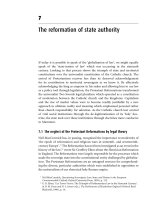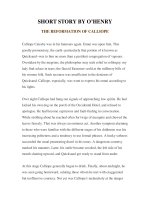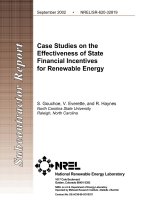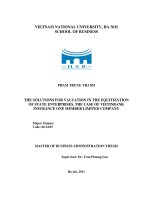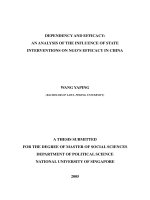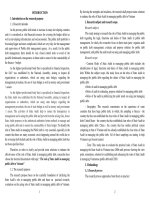The reformation of state authority
Bạn đang xem bản rút gọn của tài liệu. Xem và tải ngay bản đầy đủ của tài liệu tại đây (156.59 KB, 27 trang )
7
The reformation of state authority
If today it is possible to speak of the ‘globalisation of law’, we might equally
speak of the ‘state-isation of law’ which was occurring in the sixteenth
century. Looking to that process shows the triumph of state and territorial
constitutions over the universalist constitution of the Catholic church. The
arrival of Protestantism receives less than its deserved acknowledgement
for its contribution to territorial sovereignty as we know it. By effectively
acknowledging the king as emperor in his realm and allowing him to use law
as a policy tool through legislation, the Protestant Reformations transformed
the universalist Two Swords legal pluralism which operated as a constitution
of moderation between the Catholic church and the kingdoms. Capitalism
and the rise of market values were to become readily justifiable by a new
approach to ultimate reality and meaning which emphasised personal rather
than church responsibility for salvation. As the Catholic church lost control
of vital social institutions through the de-legitimatisation of its ‘holy’ doc-
trine, the state took over those institutions through doctrines more conducive
to Mammon.
7.1 The neglect of the Protestant Reformations by legal theory
Neil MacCormick has, in passing, recognised the importance to modernity of
‘the epoch of reformation and religious wars in sixteenth- and seventeenth-
century Europe’.
1
‘The Reformation has not been investigated as an event in the
history of the law’,
2
wrote Sir Geoffrey Elton about the Henrician Reformation
in England. The Reformations were largely responsible for the processes which
made the sovereign state into the constitutional entity challenged by globalisa-
tion. The Protestant Reformations are an untapped resource for comprehend-
ing the diverse, particular authorities which were established in opposition to
the universalism of our rhetorical holy Roman empire.
111
Neil MacCormick, Questioning Sovereignty: Law, State, and Nation in the European
Commonwealth (Oxford: Oxford University Press, 1999), p. 123.
112
G. R. Elton, ‘Lex Terrae Victrix: The Triumph of Parliamentary Law in the Sixteenth Century’,
in D. M. Dean and N. L. Jones (eds.), The Parliaments of Elizabethan England (Oxford: Basil
Blackwell, 1990), p. 16.
Marsiglio of Padua, whom we encountered in the context of the decline of
the Christian commonwealth,
3
was important for laying the philosophical and
juridical groundwork. He had maintained that the ruler has his primary origin
in the legislator – the whole body of citizens – with the power to depose rulers
and to make laws. For Marsiglio, civil law was characterised by its relationship
to coercion, not by the verity of its content. The priesthood was relegated, in
Marsiglio’s thought, from significance in the exterior, political dimension of the
Space–Time Matrix to the future orientation of the Time Axis – the future life
or afterlife – by being allocated the role of teaching God’s promises to men. The
truth or falsity of resurrection or eternal reward or punishment was irrelevant;
rather, the value was in the fear it struck in the human mind and the engendered
social order. The evangelical law was to distribute reward or punishment in the
future life in contrast to the worldliness of the civil law.
4
The priestly, other-
worldly power was convenient for its use as a political tool for moral manipu-
lation in the present by secular government.
A salient reason for the failure of the universalist moral authority by which the
Catholic church had sought to regulate its body of believers was church cor-
ruption. Although the buying and selling of church offices (simony) and clerical
marriage (nicolaism)
5
were no longer the vices of the day, the selling of indul-
gences reflected poorly upon the Catholic church. There was much diversity in
the practice of the granting of indulgences. Alleged relics of holy personages such
as fragments of their bones or associated antiques such as pieces of the Saviour’s
crucifix were made compulsory purchases for members of the church, to gain
access to heaven. The Gregorian Reformation was failing: secular government
and society could not look to the Roman church for ultimate moral guidance;
the idea that grace and justice were concerns of a government inspired by the
church could no longer be taken seriously.
6
Against this background, it became
more difficult for the church to maintain its ‘supranational’ jurisdiction.
Of broad significance to the Western world is the origin in the Reformations
of the state domination of law. A legacy of that presumptuous, ontological asso-
ciation of law with the state has been the presentation by contemporary legal
theory of supranationality, and more notably the constitutional jurisprudence
of the European Union, as threatening for its novelty. There was, in fact, an
advanced medieval precedent in Europe.
7.2 Supranationality legislation prior to the Reformations
Medieval Europe had been generally governed, as we have seen, by the Two
Swords constitutionalism of shared jurisdiction between the secular ruler and
145 The reformation of state authority
113
See ch. 6, section 6.3.1, pp. 129–30 above.
114
Joan Lockwood O’Donovan, Theology of Law and Authority in the English Reformation
(Atlanta: Scholars Press, 1991), pp. 23–5.
5
See ch. 5, section 5.2.1, p. 98 above.
116
See Harold J. Berman, Faith and Order: The Reconciliation of Law and Religion (Atlanta:
Scholars Press, 1993), p. 87, citing Myron Gilmore.
the papacy, which had comprehended a widespread legal pluralism. Emperors,
princes and kings had quarrelled for centuries with popes and bishops, within
legal parameters, about the proper scope of their respective secular and spirit-
ual jurisdictions. Other legal systems had subsisted, such as feudal, manorial,
urban and mercatorial law.
In France, in the second half of the fifteenth century, Louis XI had insisted
that judgments of ecclesiastical courts were subject to the review of the
Parlement of Paris and priests required permission of the king to travel outside
France.
7
Papal taxes, appeals to Rome and election of French bishops were regu-
lated by the French Pragmatic Sanction of Bourges (1438) and the Concordat
of Bologna (1516). The German-speaking polities of the Holy Roman Empire,
of which there were 364, were subject to the jurisdiction of pope and canon law,
emperor and imperial law, and local princes and rulers. German laws compar-
able to those in France and England (discussed below) were understandably
more ‘sporadic’in application.
8
England had statutes of praemunire, first enacted in 1353 by Edward III
(reigned 1327–77). They were intended to protect the royal courts from inter-
ference by foreign courts. They amplified a prohibitory procedure originally
devised by Henry II (reigned 1154–89), staying proceedings in an ecclesiastical
court until the crown had decided where jurisdiction lay. By suing on a writ of
praemunire, an affected applicant could seek to prevent a respondent from
having a matter heard in a court other than the king’s court; ecclesiastical
courts, in particular, were held to exceed their jurisdiction when there was a
remedy at common law.
9
7.3 From ‘Two Swords’ to single sword sovereignty
Henry VIII (reigned 1509–47) was to use parliament to achieve his ends with
the result that exterior, political goals could be legislated in a manner which was
abstracted from the interior, moral atmosphere of the individual. This is what
I term ‘the legislative mentality’. The English emergence is explored because it
is paradigmatic of the mentality; and other European developments were not
as sensational. The general Western experience will later be considered more
briefly.
146 State Formation and Reformation
117
See Martin van Creveld, The Rise and Decline of the State (Cambridge: Cambridge University
Press, 1999), p. 66.
118
John Witte Jr, Law and Protestantism: The Legal Teachings of the Lutheran Reformation
(Cambridge: Cambridge University Press, 2002), p. 41, and ch. 1 more generally with respect
to Germany.
119
Sir William Blackstone, Commentaries on the Laws of England,4 vols. [1783] (New York:
Garland Publishing Inc., 1978), bk. IV, ch. 8; see too R. H. Helmholz, The Oxford History of
the Laws of England, Volume I: The Canon Law and Ecclesiastical Jurisdiction from 597 to the
1640s (Oxford: Oxford University Press, 2004), pp. 175–81.
7.3.1 The English experience under Henry VIII
Henry’s marriage to Catherine of Aragon had failed to produce a male heir. This
failure was a failure to produce a monarch, despite the fact that they had already
borne a daughter, Princess Mary. No woman had ever sat on the throne in
England in her own right (as opposed to carrying the title ‘queen’ as an incident
of being the wife of the king), and it was doubtful that the subjects would now
submit to a queen so enthroned.
10
There was also a fear that Mary might be
paired with a Continental ruler
11
(as eventually she was). Henry’s bastard son,
the Duke of Richmond, could only further confuse the royal succession.
12
King
Henry required a son for the constitutional stability of the realm. He had to
obtain a divorce from Catherine virtually at all costs. Pope Clement VII was not
minded to grant the annulment of the marriage as a matter of theology and also,
no doubt, because Catherine’s nephew, Emperor Charles V of the Holy Roman
Empire, at that time effectively controlled the papacy. Nor would Clement, in
the political climate, have wished to undermine papal power by countermand-
ing the dispensation his predecessor, Pope Julius II, had granted Henry to marry
Catherine in the first place.
13
The infertile seeds of Henry’s seemingly private issue gestated into a grave
constitutional problem at the most public of levels. The mechanism for usurp-
ing from the papacy the spiritual jurisdiction over the marriage was inge-
nious and also historically and legally grounded in Roman law and the logic of
legal manipulation. Henry invoked Roman public law, even though it had
never been received in England as positive law in any widespread doctrinal
sense. Justinian’s Corpus could be used to support the legal and political supe-
riority of the secular sphere as against the spiritual sphere. Indeed, the Roman
law had been used, in a less totalising way, for centuries in Europe for this
purpose, in France, Germany, Sicily, Bohemia and even by Richard II in
England, who reissued praemunire legislation in 1392. Rex in regno suo est
imperator
14
– the king is emperor in his own realm. In effect, this condensed
the power of the Roman ‘lord of the world’ concept of the emperor (dominus
147 The reformation of state authority
110
J. A. Froude, The Divorce of Catherine of Aragon: The Story as Told by the Imperial Ambassadors
Resident at the Court of Henry VIII [1891] (New York: Ams Press, 1970), p. 22.
111
J. J. Scarisbrick, Henry VIII (London: Methuen, 1976), p. 202.
112
S. T. Bindoff, Tudor England (Harmondsworth: Penguin, 1964), p. 69.
113
Catherine had originally been married to Henry’s late brother, who had left Catherine a
widow. Henry had then obtained dispensation to marry Catherine. At canon law, in order for
Henry to have been able to have his marriage with Catherine annulled, there had to be some
reason, such as an invalid dispensation being granted to Henry in the first place. On the
theological arguments, see Scarisbrick, Henry VIII,pp. 219–29, for a discussion of the
prohibition in Leviticus 18: 16 and 20: 21, which seems to oppose the prescription in
Deuteronomy 25: 5 for the brother of a deceased man to marry the widow.
114
Azo (1150–1230) had defined the independence of royal authority in this way: see
K. Pennington, ‘Law, Legislative Authority, and Theories of Government, 1150–1300’ in
J. H. Burns (ed.), The Cambridge History of Medieval Political Thought c.350–1450
(Cambridge: Cambridge University Press, 1988), p. 433.
mundi)
15
into a neat territorial package. Henry VIII claimed to be emperor of
his realm – of his sphere of containable disruption. The Corpus contained the
role and function of the late Roman emperor: it ‘conveyed the concept of prop-
erly understood monarchic government within the framework of that body of
law which had always been considered to be the acme of jurisprudential
achievement, even if it had not been “received” as a positive legal system ...’
16
[italics added].
The fact that there had been no positive reception of this jurisprudence, yet
that it could be regarded in the sixteenth century as an acme of jurisprudential
achievement to which resort could be had for authoritative norms, illustrates
the transcendent nature of Western legal science. This science could be con-
strained neither by time nor space. It also demonstrates the historical nature of
Western law, in particular the strategy for legitimacy which the past may recur-
sively provide for obtaining allegiance. The use of such fictions is ‘a sign of
change occurring and a means whereby it does occur’ even though the fictions
‘are legal rules which deem something to be so even though everyone knows it
is not’ [original emphasis].
17
Henry VIII was no Roman emperor. Secular mon-
archs had assumed the plenitudo potestatis – fullness of power – which derived
from the papal vicarship of Christ and the constitutional position of the Roman
emperor.
18
It was an identification with terminology which enabled Henry to apply the
formulation by Ulpian, glossed in the canon law by Gratian. This was notwith-
standing the fact that Roman jurists ‘had never analysed legislative authority,
jurisdiction, or delegated power in any systematic way’.
19
The reasoning pro-
ceeded like this. Any government worth its name must have control of the
public law.
20
‘Public law covers religious affairs, the priesthood, and offices of
state’: Digest 1.1.1.
21
Using this Roman public law theory, Henry was to attempt
to do to the church and more what Constantine, the first Christian Roman
emperor (reigned 306–37), had done in his time. Constantine, through the
148 State Formation and Reformation
115
On the dominus mundi concept, see James Muldoon, Empire and Order: The Concept of
Empire, 800–1800 (New York: St Martin’s Press Inc., 1999), ch. 4.
116
Walter Ullmann, ‘This Realm of England is an Empire’ (1979) 30 Journal of Ecclesiastical
History 175–203, 176. See too Franz Wieacker, A History of Private Law in Europe, With
Particular Reference to Germany,trans. Tony Weir (Oxford: Oxford University Press, 1995),
pp. 98–101.
117
See Keith Mason, Constancy and Change: Moral and Religious Values in the Australian Legal
System (Leichhardt: Federation Press, 1990), p. 68. It may be harsh to dismiss such archetypal
legal reasoning as ‘historical fabrications’ as does van Creveld, Rise and Decline,p.84. Law and
constitutional development are invigorated by the finding of fictions and the making of
assertions by analogy: for example, the church as the bride of Christ, the king as the head, the
pope as the holder of the keys to heaven, the king’s body personal and body politic, We the
People of the United States etc.
18
Pennington, ‘Law, Legislative Authority’, pp. 435–6.
119
See Pennington, ‘Law, Legislative Authority’, p. 430.
120
Ullmann, ‘This Realm of England’, 179–80.
121
Theodor Mommsen and Paul Krueger (eds.), The Digest of Justinian, trans. Alan Watson
(Philadelphia: University of Pennsylvania Press, 1985).
application of corporate status, had given legitimate constitutional status to the
church whilst keeping it subordinate to the fully applicable public law. As a
corollary, Constantine’s imperial right to convoke church councils was con-
ceived to be within the public law. But Constantine did not interfere with the
‘complex christological matters’: he was ‘“the overseer of the external matters”
of the Church’ [italics added]. This is very significant. Interior moral allegiance
on the Space Axis was thought even then to come from the interior spiritual
realm governed by the church. This important Constantinean distinction
‘between internal and external matters was, as it were, canonised in no less a
place than the crowning formula in most royal coronation orders of medieval
Europe’. Ingenious prescience on the part of the young Prince Henry (or his
advisors) was to give him even greater regal licence. The changes reserved the
king’s right to act within the terms of the Roman public law in his function as
emperor of his realm. Secondly, by using the terms ‘royal’ and ‘imperial’ juris-
diction, and ‘crown’ and ‘dignity’ as interchangeable terms, Henry could be con-
stituted within Roman public law the more boldly.
22
The Act in Restraint of Appeals was the vehicle by which this constitutional
innovation was implemented.
Where by divers sundry old authentic histories and chronicles . . . this realm of
England is an empire . . . governed by one supreme head and king . . . with
plenary, whole and entire power . . . to render and yield justice to . . . all subjects
within this realm, in all causes . . . without restraint or provocation to any foreign
princes or potentates of the world.
23
The ‘divers . . . histories and chronicles’ upon which the new political theory
was founded made the Act in Restraint of Appeals the only act to call for the tes-
timony of historians for legitimacy.
24
It was by this reasoning that the scope of
the Act in Restraint of Appeals could be legitimate, and the course of English
history altered: the monarch could have absolute authority in his own realm.
The first base of this was the king’s ancient personal sovereignty from which
derived all judicial authority in the realm. The second base was the king’s terri-
torial sovereignty, which was derived from a decretal of Pope Clement V in
1313: from the lex diocesana,subjects of the bishop, and by extension the king,
could not lawfully be cited to appear in court outside the territorially defined
jurisdiction. For the king, this territorially restricted jurisdiction was in fact the
kingdom – his newly expanded sphere of containable disruption. In delimiting
the domain of the territorial sovereignty of bishops, the pope had made that
domain inviolate. Henry could use this to his advantage: ‘no jurisdiction could
be exercised over the king by an organ extra territorium’. Furthermore, Henry
cited more canon law against the pope: nobody should be cited to attend court
149 The reformation of state authority
122
See Ullmann, ‘This Realm of England’, 181–3.
123
‘The Act in Restraint of Appeals’: 1533: 24 Henry VIII, c. 12 extract in G. R. Elton, The Tudor
Constitution: Documents and Commentary (Cambridge: Cambridge University Press, 1960),
p. 344.
24
Elton, ‘Lex Terrae Victrix’, p. 21.
if involving a journey of more than two days.
25
The pope could not touch the
king in the regnal empery. Specific spiritual (as opposed to Constantinean exter-
nal,ecclesiastical) matters were engulfed by royal authority by virtue of Henry’s
coronation as typus Christi (figure of Christ) and the nomination of the king,
centuries before by Bracton, as vicarius Dei (deputy of God).
26
The authority of God had been the starting-point for the Henrician reform-
ers, although the way this authority was accomplished, through parliament as
the grand means of legitimacy, was radical. In England, in the Tudor period
alone, as much bulk in legislation was enacted as had been in existence to that
reign since the Magna Carta.
27
Theologically, Henry’s headship of the church
was owed to God, under new Church of England thought; however, ‘the reality
of his powers as supreme head he owed to the common law, enlarged for this
purpose by the relevant legislative authority’.
28
In official statements, the royal
supremacy was seen to originate not only with the lex divina but also with the
lex parliamentaria; the church existed under the rule of parliament, and not just
the king.
29
The challenge to the social status of natural and divine laws by the king and
his parliament opened up the king’s law itself to challenge. The very resort
Henry made to parliament for monarchical power would be the eventual
undoing of monarchical power. Henry had unleashed ‘the legislative mentality’,
which parliament was able to usurp from him and subsequent monarchs.
Ultimately, this foreshadowed the parliamentary absolutism of modern times,
and the monopoly which the state claims over law. Parliamentary sovereignty
was set upon its trajectory, within a limited national territorial sphere of con-
tainable disruption.
Needless to say, Henry obtained his divorce, and several subsequent wives
with fewer regulatory impediments.
7.3.2 The general Western experience
In Germany, Lutheranism authorised the territorial prince as the ultimate
source of law.
30
At the level of Western generality, monarchical and then leg-
islative absolutism was eventually to remove the moral attachments of ordinary
people from the laws governing them. The most important institution of law
creation was to become the territorial monarch acting with the royal council or
parliament, which could declare or make good or bad laws mechanically with
150 State Formation and Reformation
125
Ullmann, ‘This Realm of England’, 184–8.
26
Ibid., 197.
127
See J. H. Baker, An Introduction to English Legal History (London: Butterworths, 4th edn
2002), p. 207.
128
Elton, ‘Lex Terrae Victrix’, pp. 25, 27. ‘[W]ithout the cooperation of parliament it would . . .
[have been] impossible to equip the royal supremacy with practical reality’ (p. 23).
129
Ibid., p. 31.
130
Harold J. Berman, Law and Revolution, II: The Impact of the Protestant Reformations on the
Western Legal Tradition (Cambridge, MA: Harvard University Press, 2003), p. 65.
the emerging state bureaucracy and associated coercive powers. Increasing
popular participation in law could of course increase the allegiance of those
involved in the creation of new laws or, much later, the election of politicians
for a mandated purpose. That is, however, a very political idea of law. It is also
particularistic, because it does not defer to ethical principles in the same way as
religiously based, universalist justifications for law do. Although Western laws
mainly fall within the principled bounds of rule of law (except in revolutionary
times), the basis for legislated laws may be no more inherently just or moral
than the political flavour of the month. The Western world was being fractured,
and there were to be many different political worlds or states in the increasingly
incoherent normative universe of Europe, continuing the demise of our rhetor-
ical holy Roman empire.
Generally, in Western Europe, monasteries were dissolved and there was
large-scale confiscation of church property – 25–30 percent of all land – in
Scotland, the Scandinavian countries, England, Germany, Bohemia, Poland,
Hungary, Switzerland, France and the Low Countries.
31
In the German princi-
palities, Catholic institutions were secularised and populated by lay people,
with doctrinal changes implemented by local magistrates.
32
The Habsburg
Charles V, as Holy Roman Emperor, was unable to contain the spread of
Lutheranism in Germany. Although defeating the Schmalkaldic League of
Protestant rulers, he failed to prevent the disaffection in Germany which was
encouraged by Henry II of France. When Charles finally abdicated in 1555,
Protestant and Catholic rulers ‘swept through the country like raging boars’,
secularising church property.
33
In Germany, secular courts took over ‘the crimes
of heresy, blasphemy, sumptuousness of dress’; marriage and divorce, wills and
charities were also assumed, and cathedral schools, libraries and universities
were all established and placed under the secular authorities, together with what
we now consider to be the ‘welfare’ obligations of a government.
34
In many respects, the changes to the institutions of government were
minimal (apart from the new legislative facility). Ecclesiastical courts remained
ecclesiastical courts. The hierarchy was, however, capped at a territorial level. In
effect, the church became a department of the state and the territorial borders
of the realm officially garrisoned the inhabitants.
7.4 Protestant legal authority
In chapter 6, because of space constraints, attention to particular legal systems
was concentrated upon Germany and England. So too will attention now be
confined to those territories for exploring the new legal philosophy. References
151 The reformation of state authority
131
van Creveld, Rise and Decline,pp. 67–8.
132
See O. F. Robinson, T. D. Fergus and W. M. Gordon, European Legal History (London:
Butterworths, 1994), [10.6.1]–[10.6.3].
33
van Creveld, Rise and Decline, p. 101.
134
Berman, Faith and Order, p. 99; and his Law and Revolution II,p.64; Witte, Law and
Protestantism,p.84.
to legal authority can be broadly inferred to France and Switzerland when dis-
cussion refers to John Calvin in the balance of this chapter.
7.4.1 German legal philosophy
In 1517, Martin Luther famously nailed his Ninety-five Theses on the door of
the church of the prince-elector of Saxony, in Wittenberg. The document called
for the abolition of papal jurisdiction and attacked abuses of papal authority
(including the sale of indulgences) and the interposition of the church between
the human and God. Three years later, he fuelled a bonfire with writings includ-
ing Gratian’s Decretum and canon laws.
Lutheran legal philosophy was to preach the supremacy of the state given the
otherworldliness of Christ’s Kingdom. Philip Melanchthon posited this in the
Protestant manifesto, the Confession of Augsburg (1530). By this emerging
theory, the Catholic church, and the laws which it made and upheld, were
unnecessary for the salvation of the soul. Sinful humans were justified by faith
alone, not by works or actions (the theological doctrine of solifidianism).
Sinners, according to Catholicism, relied upon the divine authority of the
priesthood to hear the sinner’s confession and to prescribe the works (penance)
by which the sin could be purged. Church law, as the revelation of God, sought,
in addition, to offer the standards by which humans could minimise sin. Only
the Bible, for Luther, offered this possibility. Law, to him, was irrelevant to this
process. Salvation could not be earned or mediated by the priesthood.
35
With echoes of Marsiglio, Luther offered a ‘two kingdom’ approach to polit-
ical theology, encapsulating, from the Augsburg Confession, the supremacy of
the state over the otherworldliness of Christ’s Kingdom. Humans were destined
to live first in the earthly and then in the heavenly kingdom. The visible polit-
ical regime of the secular authority should reign on earth. The spiritual regime
of the true church, for him, was invisible and did not extend to law: its visibil-
ity could extend only to preaching the word of God and administering the
sacraments.
36
The Thomist tradition of (natural) law had taught that divine revelation was
accessible to human reason; that is, in modern parlance, divine truth could be
the aim of law. Lutheran law, however, was not interested in truth outside the
already divinely posited Bible – law was simply to enforce obedience. For Luther,
truth was of the second, heavenly kingdom, not a realistic concern for those
inhabiting the temporal first kingdom of the earth. Law as an expression of
human reason was ‘inevitably corrupted by man’s innate inclination to greed
and power’ and natural law was confined to the Bible,
37
making it difficult to
152 State Formation and Reformation
135
Harold J. Berman and John Witte Jr, ‘The Transformation of Western Legal Philosophy in
Lutheran Germany’ (1989) 62 Southern California Law Review 1575–1660, 1582; Berman, Law
and Revolution II,p.42; Witte, Law and Protestantism,pp. 55–9.
136
See Berman and Witte, ‘Transformation’, 1586–90; Berman, Law and Revolution II,pp. 40–1;
Witte, Law and Protestantism,ch. 3.
37
See Berman and Witte, ‘Transformation’, 1617–21.
reconcile natural law with positive law.
38
People were unable, without coercion,
it was thought, to avoid evil and do good by their own reason and will. An
attempt to involve the soul with law or its advancement through interpretation
was an incursion into God’s power over the soul.
39
Consequently, the Ten
Commandments (not scholastic reason) were posited as the basic natural law
on Earth and used as a model for positive law.
40
Yet, the Christian conscience
was the ultimate source for moral decisions and could disobey civil authorities
as a matter of inward reflection with God’s grace, although not as a matter of
human reason.
41
Here we have a complicated recipe for civil disobedience;
although the state could practically smash that disobedience with its political
might. The trend to be identified is the written objectification of natural law
from an interior morality and conscience into an exterior, more readily identi-
fiable, standard to be administered by the state.
Roman law and the German ius commune which was perceived to embody
the German spirit were to figure prominently in the thought of the Lutheran
jurist Philip Melanchthon. Chiefly the attraction lay in the capacity for peace
which the imperial protection of the Roman law offered in the face of the
Peasant War of 1524–5. There was also the continued theological association of
Rome with the last of the four monarchies of the Old Testament Book of
Daniel – a monarchy which offered a universal empire of God-given peace.
42
Roman law was the law of peacemakers for four main reasons: it was written
and offered certainty; equity was available if justice required the departure
from legal inflexibility; arbitration was extensively described in two titles of
Justinian’s Corpus and equity was suited to arbitration; and, most importantly,
according to James Whitman, choice of law technology was very advanced in
the ius commune. That is, customary, parochial, interior territorial laws could
be embraced, on our Space Axis, in the compelling legal science of the more
exterior ius commune,provided proof could be adduced.
43
The prospects these
factors offered, overall, for peace in a violent Germany, were immense. By 1530,
this was reflected in Luther’s recantation of his early denunciation of lawyers.
He now referred to them as ‘Angels of the Empire’ and ‘Apostles of the Kaiser’.
44
153 The reformation of state authority
138
Wieacker, Private Law, p. 209; Witte, Law and Protestantism, pp. 124–5.
139
Berman and Witte, ‘Transformation’, 1627.
40
Witte, Law and Protestantism, pp. 126–7.
141
Berman and Witte, ‘Transformation’, 1647; Berman, Law and Revolution II,pp. 92–3; and in
detail, Quentin Skinner, The Foundations of Modern Political Thought, 2 vols. (Cambridge:
Cambridge University Press, 1978), vol. II, ch. 7.
142
James Q. Whitman, The Legacy of Roman Law in the German Romantic Era: Historical Vision
and Legal Change (Princeton: Princeton University Press, 1990), pp. 4, 21–3. Cf. ch. 4, section
4.3, p. 83 and ch. 6, section 6.3.2, p. 135 above. On the medieval political theology, see
Muldoon, Empire and Order, ch. 5.
143
Whitman, Legacy of Roman Law,pp. 7–8. On this aspect of the ius commune,see ch. 6, section
6.2.1, pp. 120–1 above.
144
Whitman, Legacy of Roman Law, p. 23. On dismounting this antinomian platform of ‘jurists
are bad Christians’ and ‘I shit on the law of the emperor, and of the pope, and on the law of
the jurists as well’ to law as a blessing, see more fully Witte, Law and Protestantism,p.4 and
ch. 4.
